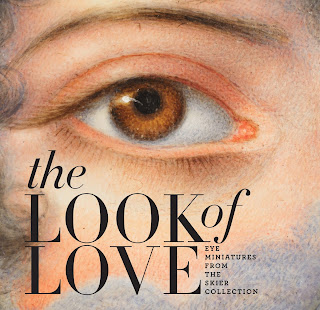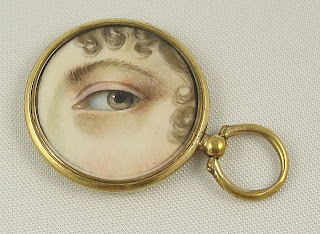I have a new “guilty pleasure” book for you. The Look Of Love: Eye Miniatures From The Skier Collection, the catalogue of the Birmingham (Alabama) Museum of Art’s exhibit of eye miniatures dating from the 1780s to the 1820s.
Jo Manning, author of My Lady Scandalous, the biography of famous courtesan Grace Elliot, and of many fine Regency romances, contributed fictional vignettes about certain eye miniatures, imagining the circumstances of the creations of the jeweled pieces of art. The addition of these vignettes to the catalogue seemed an inspired idea, because the identities of most of the subjects in the collection are unknown.
Apparently it was George IV, then Prince of Wales, who commissioned the first eye miniatures. When the Prince secretly married the Catholic widow, Maria Fitzherbert, they exchanged miniatures of their eyes, painted on ivory and set in jewels, as tokens of their love. Soon it became the fashion for lovers and loved ones to bestow these tiny portraits of a single eye, made into brooches, pendants, even rings, on their favored ones. It was the perfect love token for clandestine lovers–one eye was enough to spark the memory of the person, but not enough for another person to identify whose eye it was.
Some eye miniatures were not secrets. They might be gifts between husbands and wives, mothers and sons, betrothed couples. Some were sad mementos of a loved one who died. But the identities of so many miniatures that were gifts from secret lovers are lost to us.
What remains are beautiful, sometimes spooky, images set in gold, surrounded by gems, or decorating tortoiseshell boxes. Some of the jewelry include woven locks of hair on the underside of the miniature. One includes the miniature of a hand; others, inscriptions such as “Esteem the giver.” One of the most unusual settings is a tiny image of an eye on a toothpick box. Another, in the book but not in the exhibit, is an eye painted onto a porcelain teacup.
These were gifts whose only purpose was to convey love. What an inspiration for romance writers and readers!
Read Jo Manning’s guest blog on the exhibition at Number One London.
Here’s an article on the exhibition from Vanity Fair.
More information on eye miniatures from Antiques Roadshow.
Preview of a scholarly article from Jstor.
I found an artist who will paint an eye portrait, but I think one of us (Amanda???) once found someone else who accepted commissions for eye miniatures.
Have you read (or written) about eye miniatures in any Regency Historicals?


